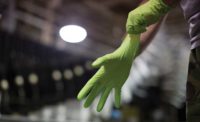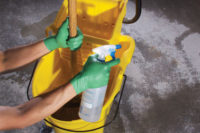
With emotions riding high after this spring’s dramatic Gulf oil spill, both volunteers and workers assigned to the task rushed in to help with the cleanup. Sometimes, those on the front lines did so with little thought to the dangers to which they might be exposed.
The availability and use of effective personal protection equipment (PPE) has been and continues to be of vital concern to those managing the aftermath of the spill. Early on, OSHA cited potential skin irritation and dermatitis from workers getting weathered oil on their skin or in their eyes as a major concern.
As the spill lingered on first one month, then two and three, gloves for the thousands of cleanup workers became more and more of an issue. Manufacturers juggled regular orders to accommodate the emergency need for more gloves - particularly nitrile gloves, although nitrile, neoprene, and PVC-coated gloves are all appropriate for oil cleanup work. (Latex gloves would be rapidly destroyed by oil.) Out on the booms, the demand for more and more heavy-duty PVC gloves increased. As the oil spill continued, so did the demand for PPE - now.
Crisis mode
With so much glove manufacturing overseas, delivery times for beefed up glove orders were uncertain. As the one U.S. domestic manufacturer of nitrile gloves, our company moved into crisis mode, in continual dialogue with oil company officials and establishing a 24-hour Oil Spill Hotline. New lines were added to manufacturing operations to get the right gloves to cleanup workers fast, and shipping took on a ’round-the-clock nature.At most glove companies, the cooperative efforts to achieve a fast response went well beyond manufacturing. Laboratory operations also came into the picture, testing alternative glove types’ effectiveness against not only oil but also against the specific dispersants being used in the cleanup. This was particularly important because one of the dispersants used contains 2-butoxyethanol, for which OSHA’s Permissible Exposure Limit for airborne exposures is 50 parts per million for up to a full work shift.
With the oil leak stopped, the amount of oil coming on the Gulf Coast shore has decreased dramatically. However, oil can still be found in places along the Gulf Coast, and scientists believe that at least 25 percent of the oil remains hidden from the human eye.
Beware long-term risks
As Gulf Coast residents and businesses continue to deal with the after-effects of the spill, using proper hand protection remains an important priority. No one should handle oil-covered wildlife or actual tar balls without the protection of a nitrile glove. There have been few studies that have examined the longterm health risks of exposure to oil. According to an AP report from the Centers for Disease Control, brief contact with small amounts of light crude oil and dispersants is not thought to be harmful. In contrast, extended exposure to dispersants can cause central nervous system problems, or damage to the blood, the kidney, or the liver, and leave a metallic taste in the mouth.Cleanup workers continue to be advised to follow federal guidelines that recommend that anyone involved wear protective equipment such as gloves, safety glasses and clothing, The risks of injury to individuals remain, even though the catastrophic spill has been capped.

